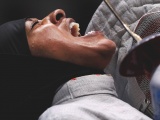What to Know
- New York City has recorded just two confirmed COVID-19 deaths in the last four days, yet another sign of the progress Gov. Andrew Cuomo says the city -- and state -- must work hard to maintain
- Slipping compliance at home compounds the growing national threat; Mayor Bill de Blasio says NYC will start implementing checkpoints to help enforce the state's 14-day quarantine order for hotspot travelers
- Nationally, the U.S. death toll has topped 157,000 and diagnosed COVID cases are approaching 5 million, by NBC News estimates; latest virus projections expect up to 7,500 deaths each week for the next 4 weeks
Mayor Bill de Blasio said New York City would start implementing checkpoints across the five boroughs to help enforce Gov. Andrew Cuomo's quarantine order for travelers from viral hotspots, citing the ongoing national COVID threat.
The measure announced Wednesday is the first significant effort by New York City specifically to help enforce the 14-day quarantine for travelers from 34 states and Puerto Rico. In revealing it, de Blasio said the state was "absolutely right" to impose the travel restriction in the first place. Cuomo announced it in late June.
The governor has said the quarantine itself is imperfect and Mayor de Blasio admitted New York City's new enforcement plan has some caveats as well. But the idea, the mayor said, is to send a strong message to people coming in.
"The checkpoints are going to send a very powerful message that this quarantine is serious. Even if we can't reach every single person I think it'll get the message across," de Blasio said. "We don't want to penalize people. We want to educate them, make sure they're following the rules."
Travelers who land at New York airports are required to fill out a form for contact tracing purposes. The same requirements apply for travelers coming to the state by car, train or bus -- though travelers who come by those means are more likely to slip through the cracks.
Starting Wednesday, the city will implement COVID-19 checkpoints at key entry points into the city, de Blasio said. They will vary daily, though the mayor said one will appear at Penn Station on Thursday. Another is planned for Port Authority.
Sheriff Joseph Fucito said there will be “a random element” and every sixth or eighth car on a bridge might be checked.
Travelers will be given the state contact forms to fill out. Refusal to submit the form can result in mandatory quarantine and a $2,000 fine, while failure to comply with the overall order can incur up to a $10,000 civil penalty.
The city hopes to implement "full-fledged checkpoints" where viable and hold them at other locations where they're unlikely to create major traffic backups. De Blasio says the city stands ready to assist travelers who need a safe place to isolate for 14 days. The test and trace team has already made nearly 90,000 calls to travelers affected by the quarantine order and sent nearly 21,000 texts.
"We have been working incredibly hard to drive down all the cases in New York City," Dr. Ted Long, head of the test and trace program, said. "We want you to come into New York City but we need you to quarantine for two weeks."
The idea is to prevent the COVID surge currently overwhelming the nation from returning to the former epicenter of the national crisis. Over the last seven days, one person has died every 80 seconds from COVID in America. And the pace at which those 7,486 people died appears to be accelerating, NBC News reports.
New York City snapped its three-day streak of zero confirmed COVID deaths Wednesday, recording one each in Brooklyn and the Bronx, though it continues to see progress from a devastating stretch in April that cost hundreds of lives a day. It, along with the rest of the state, is in the fourth and final phase of Cuomo's reopening plan -- but the city took a modified approach to the last two steps, opting to shelve indoor dining and mall and museum reopenings indefinitely.
Asked Wednesday when he thought indoor dining, gyms or malls might return in New York City, de Blasio said he doesn't see it as a reality before Labor Day. He is excruciatingly conscious of the need to protect New York City's COVID progress, given the depths from which it -- and the state -- had to crawl to get to today.
Statewide COVID hospitalizations fell to 564, down from a peak of 20,000 in April, while the daily test positivity rate remains at 1 percent over a seven-day rolling average. The five boroughs have that same low positivity rate, which is one of the lowest in the nation and a far cry from the 59 percent daily rates it saw in April.
Daily Percentage of Positive Tests by New York Region
With all of New York state in some phase of reopening, Gov. Andrew Cuomo is shifting his focus to monitoring test results on a daily basis across each region to identify potential hotspots before they emerge. Here's the latest tracking data by region. For the latest county-level results statewide, click here
Source: ny.gov
Cuomo marked the somber note of progress with a stern reminder: Don't let up yet.
"Our progress is thanks to the hard work of New Yorkers - even after two and a half months of reopening, the numbers have continued to go down," Cuomo said Wednesday. "But we learned from this crisis that nobody is safe until everybody is safe, and an outbreak anywhere is an outbreak everywhere. Surging infection rates across the country threaten that progress, so we must continue to wear our masks, socially distance and stay New York Tough."
Though Cuomo says the Empire State defied experts' expectations infection rates would rise with the reopening, he fears "it's only a matter of time" before New York faces some sort of viral resurgence. His goal is to minimize the impact when it happens.
Out-of-state travel from viral hotspots has already contributed to new clusters in New York and New Jersey. That threat compounds the one of slipping compliance locally. New York City's infection rate hasn't gone up because of the latter yet -- and Cuomo is cracking down heavily on the bar and restaurant scene.
The same story of a sustained low infection rate can't be said for New York's neighbor across the river, though. New Jersey is seeing its highest transmission rates in six weeks as people continue to attend crowded house parties and flaunt COVID precautions that drove spread down in the first place.
Gov. Phil Murphy had put New Jersey "on notice" late last week and took action Monday, re-lowering the capacity on indoor gatherings from 100 to 25 people. The restrictions remain in effect "until further notice." Murphy wants to see the rate of transmission reduce to a lower level over a seven-day rolling average.
A month ago, New Jersey's rate of transmission was 0.87. On Wednesday, it was 1.32, a slight drop from the previous two days but still high enough to be what Cuomo would consider an outbreak. At the same time, Murphy announced New Jersey's youngest COVID death to date -- a 7-month-old child.
"Our Rt is still too high, meaning coronavirus continues to spread too quickly and too widely across New Jersey," the-first term Democrat said. "We need to get this number back below 1."
Murphy continued his push Wednesday for people to wear masks in public and stay distant from one another to slow the spread of the virus, painfully aware of the number of lives it took since March to get to this point in the process.
New York and New Jersey have lost more people to the virus than any other state in the nation by a long shot, but the national death toll is rising rapidly amid the worsening crisis. Florida continues to break its single-day death records. California has also reported new daily fatality highs in recent weeks.
Nationally, the U.S. death toll has topped 157,000 and diagnosed COVID cases are approaching 5 million, by NBC News estimates.
The latest prediction from an ensemble virus forecast model anticipates more than 180,000 total deaths in the U.S. by the end of August, with up to 7,500 new fatalities each week for the next four weeks.



